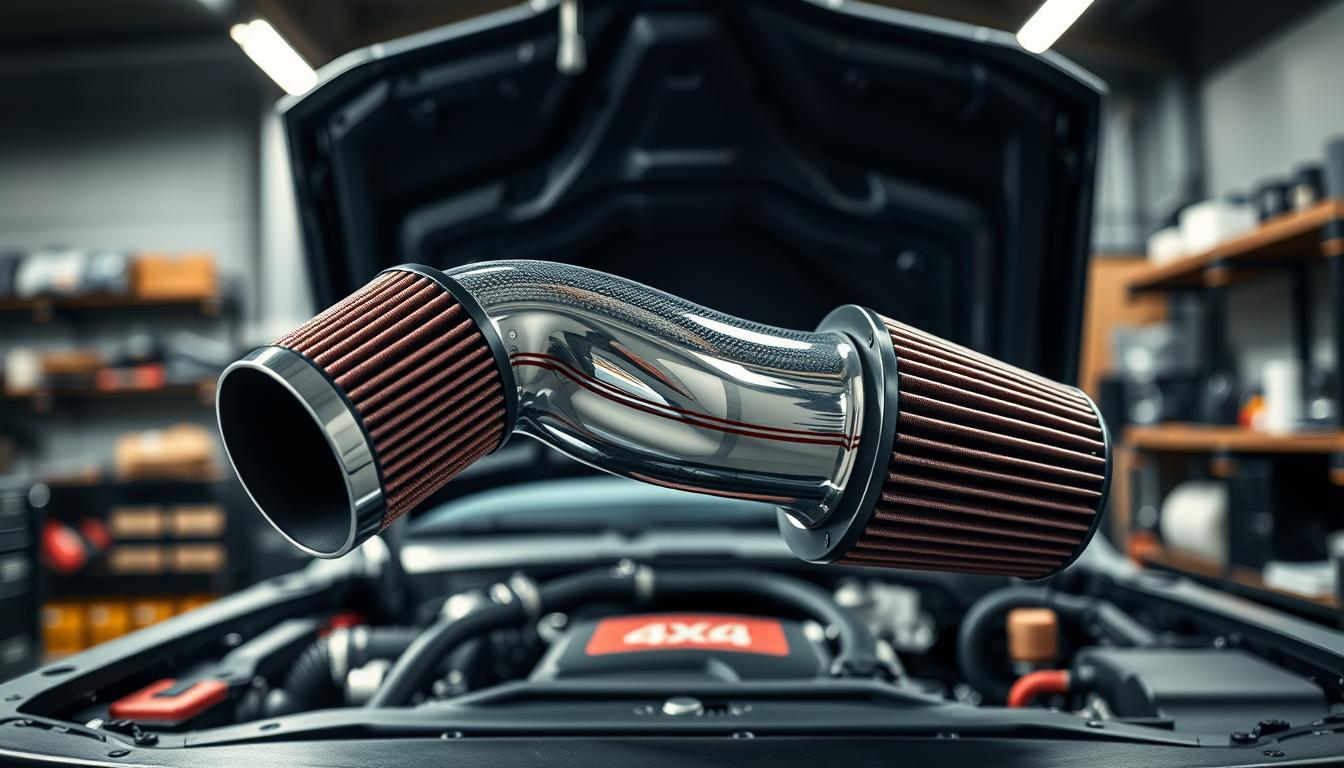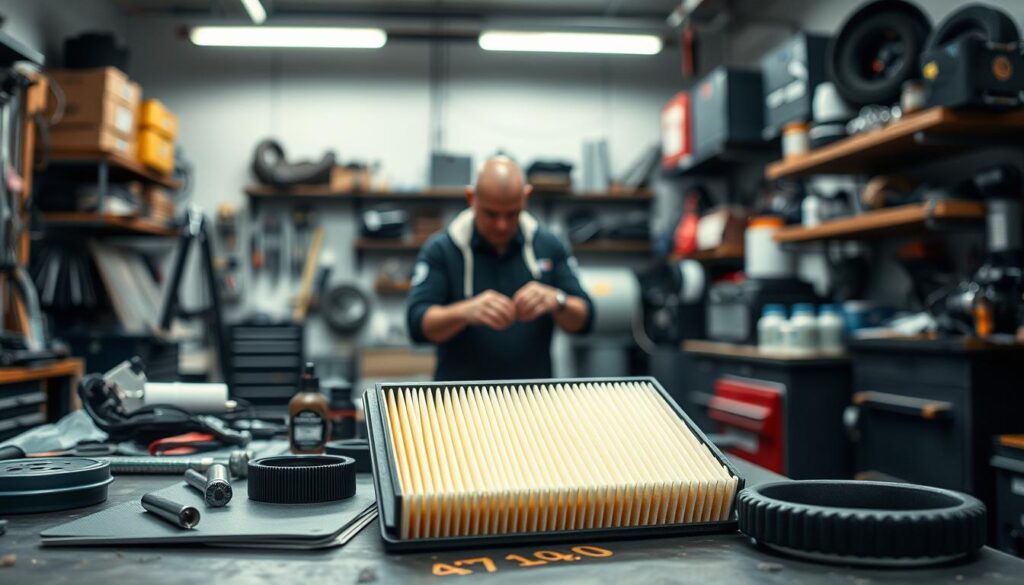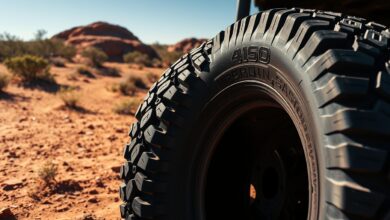How to Upgrade Your 4×4 Air Intake System

Upgrading your 4×4 air intake system can really boost your vehicle’s performance and fuel efficiency. A top-notch air intake upgrade can give you a big jump in horsepower and torque. This makes it a key upgrade for off-road fans.
K&N intakes have been tested a lot and shown to increase horsepower and torque by a lot. They improve airflow and cut down on restrictions. This lets your vehicle reach its best performance.
Key Takeaways
- Upgrading your 4×4 air intake system can improve horsepower and fuel economy.
- K&N intakes are extensively tested to provide a guaranteed increase in performance.
- A high-quality air intake upgrade is key for off-road enthusiasts.
- Improved airflow and reduced restrictions can boost your vehicle’s performance.
- A 4×4 air intake upgrade can help unlock your vehicle’s full power.
Understanding the Importance of an Upgraded Air Intake
For 4×4 fans, getting a better air intake is key to better engine power. The air intake system pulls in air for fuel to make power. It’s a vital part of your vehicle.
What Does the Air Intake System Do?
The air intake system gives your engine clean air. It has parts like the air filter, intake manifold, and throttle body. The stock system works for many driving situations but might not be best for high-performance or off-road.
Key components of the air intake system include:
- The air filter, which cleans the air before it enters the engine.
- The intake manifold, which distributes air to the engine’s cylinders.
- The throttle body, which regulates airflow based on driver input.
Benefits of Upgrading Your System
Upgrading your air intake can really boost your 4×4’s performance. It improves airflow, which means more horsepower and torque. This is great for off-road fans who want more from their vehicles.
| Benefit | Description |
|---|---|
| Increased Horsepower | Improved airflow results in more power for demanding off-road conditions. |
| Enhanced Torque | Better engine response and torque delivery improve overall driving dynamics. |
| Better Fuel Efficiency | Some upgrades can lead to more efficient engine operation, potentially improving fuel economy. |
Adding an upgraded air intake to other mods, like a custom tune, can boost performance even more. Knowing these benefits helps you make smart choices for your 4×4 upgrades.
Identifying Your 4×4 Model’s Requirements
To boost your 4×4 engine performance, knowing what your model needs is key. It’s not just about picking any air intake system. You need one that fits your vehicle perfectly.
Start by figuring out your 4×4’s make and model. Each model has its own engine setup, which means different air intake systems are needed. K&N, for example, has intakes for various models, ensuring they work well together.
Compatibility Considerations
It’s vital to make sure the air intake system fits your 4×4 model. The wrong system can harm your engine, increase emissions, and lower performance. Check your vehicle’s manual or talk to the maker to find the right air intake system.
Compatibility isn’t just about fitting right; it’s also about working well with your engine’s management system. Many aftermarket suppliers have charts on their websites to help you find the perfect match.
OEM vs. Aftermarket Options
There are two main choices for air intake systems: OEM parts or aftermarket upgrades. OEM parts fit perfectly and keep your warranty intact.
Aftermarket options, like those from K&N, offer enhanced air intake for 4x4s and better performance. They often go beyond OEM standards, giving you more power and efficiency.
Choosing between OEM and aftermarket depends on what you want to achieve and your budget. For those looking to boost 4×4 engine performance, aftermarket is often the better choice. It offers customizable solutions for your specific needs.
Types of Air Intake Systems for 4x4s
Choosing the right air intake system for your 4×4 is important. There are many options, each with its own benefits. Knowing what they offer can help you make a smart choice.
Cold Air Intakes Explained
Cold air intakes pull in cooler air from outside the engine. This can make your engine burn fuel more efficiently and possibly increase power. They’re great for off-road driving because they keep your engine running well even in tough conditions.
The idea behind cold air intakes is simple. They move the air filter to a cooler spot, like near the front grille. This cools the air going into the engine.
Short Ram Intakes: Pros and Cons
Short ram intakes are easy to install. They just swap out the old air intake system. They also make your throttle respond faster.
But, they might not cool the air as much as cold air intakes. This could limit their performance in very hot weather.
| Type of Intake | Benefits | Potential Drawbacks |
|---|---|---|
| Cold Air Intake | Improved combustion efficiency, more power | More complex installation, higher cost |
| Short Ram Intake | Easy installation, better throttle response | Less effective in hot weather, less power gain |
Performance Air Filters
Performance air filters let more air through while keeping dust out. They’re a simple and affordable way to boost your 4×4’s air intake. They can make your engine run better and might even save fuel.
“A high-quality air filter can really improve your vehicle’s performance. It’s even better when you add other engine upgrades.”
When looking at Upgrading Off-Road Air Intake systems, think about the pros and cons of each. Whether you choose a cold air intake, short ram intake, or performance air filter, pick what fits your needs and driving style best.
Tools and Materials Needed for the Upgrade
Starting a 4×4 air intake upgrade needs the right tools and materials. It can make your 4×4 run better. But, you must prepare well.
Essential Tools for Installation
You’ll need some key tools for a smooth install. These include:
- Screwdrivers (both flathead and Phillips)
- Pliers and wrenches for different bolts and clamps
- Socket set for taking apart and putting back together
- Torx bits (if your 4×4 needs them)
Having these tools ready makes the job easier. It also helps avoid any extra problems.
Recommended Upgrade Kits
Choosing the right parts is key for the upgrade. Good kits usually have:
- Multi-intake size cotton media cone filters for better airflow
- Universal MAF (Mass Air Flow) sensor housings for your 4×4’s engine system
- High-performance air intake ducts for more airflow and power
These parts work well together. They give your 4×4 a big performance boost. Make sure the kits fit your 4×4 model.
With the right tools and parts, you can upgrade your 4×4. This upgrade will make your 4×4 run better and improve your drive.
Step-by-Step Installation Guide
To boost your 4×4’s performance, follow this detailed guide for a new air intake system. Upgrading your 4×4 air intake system is easy and can greatly improve your vehicle’s performance.
Preparing Your 4×4 for Upgrade
Before you start, make sure your 4×4 is ready for the upgrade. You’ll need the right tools and a new intake system that fits your vehicle.
- Gather essential tools such as a screwdriver set, pliers, and a wrench.
- Ensure the new air intake system is compatible with your 4×4 model.
- Consult your vehicle’s manual for specific instructions related to your model.
Removing the Stock Air Intake
Removing the stock air intake is a key step. It involves disconnecting the intake duct, removing the air box, and carefully taking out the MAF sensor housing.
- Disconnect the intake duct from the air box.
- Remove the screws holding the air box in place.
- Carefully remove the MAF sensor housing to avoid damaging the sensor.
Installing the New Intake System
Now that the stock air intake is removed, you can install the new system. Make sure all connections are tight and the system fits well.
- Install the new MAF sensor housing, ensuring it is securely connected.
- Place the new air box in position and secure it with the provided screws.
- Connect the new intake duct to the air box and engine.
| Component | Old System | New System |
|---|---|---|
| Air Box | Stock air box | High-performance air box |
| Intake Duct | Standard intake duct | High-flow intake duct |
| MAF Sensor Housing | Original MAF housing | Upgraded MAF sensor housing |
By following these steps, you can upgrade your 4×4’s air intake system. This will improve its performance and efficiency.
Testing Your New Air Intake System
Testing your new air intake system is key to seeing if it boosts your 4×4’s performance. After installing it, you need to test it thoroughly. This ensures it works well and efficiently.
How to Monitor Performance Improvements
To check if your vehicle’s performance has improved, look for changes in acceleration and engine response. Key indicators include:
- Increased horsepower and torque
- Improved throttle response
- Better fuel efficiency under certain conditions
Performance monitoring tools or apps can also help. They track your vehicle’s performance, giving you detailed insights into the improvements.

Adjusting Computer Parameters
Adjusting your vehicle’s computer settings is often needed to get the best from your new air intake. This involves tweaking the engine’s settings to match the new intake. It ensures your upgrade performs at its best.
Key adjustments may include:
- Reflashing the ECU to accommodate the new air intake’s airflow characteristics
- Adjusting fuel injection rates to match the increased airflow
- Fine-tuning ignition timing for optimal performance
It’s wise to get a professional tuner familiar with your vehicle’s make and model. They can make the necessary adjustments safely and correctly.
Common Issues and Troubleshooting
Modifying your 4×4’s air intake system can bring new challenges. Knowing these issues helps ensure a smooth upgrade.
Identifying Air Leaks
Air leaks are a common problem after installing a new air intake system. These leaks can lead to decreased performance and efficiency. To identify air leaks, inspect the intake system thoroughly, paying particular attention to the connections and seals.
Some signs of air leaks include hissing sounds near the intake area and a noticeable decrease in engine performance. Using a smoke test can help locate leaks more accurately.
Addressing Installation Mistakes
Installation mistakes can also hinder the performance of your new air intake system. Common mistakes include improper fitting of the intake components and loose connections.
To avoid these issues, follow the manufacturer’s instructions carefully, and double-check all connections before completing the installation.
Here’s a summary of common issues and their solutions in a tabular format:
| Issue | Cause | Solution |
|---|---|---|
| Air Leaks | Loose connections, damaged seals | Tighten connections, replace seals |
| Installation Mistakes | Improper fitting, incorrect installation | Follow manufacturer’s instructions, double-check connections |
| Performance Decrease | Air leaks, installation mistakes | Inspect system, correct installation mistakes |
By being aware of these common issues and taking steps to troubleshoot them, you can ensure that your 4×4’s air intake system operates at its best.
Maintenance Tips for Your Air Intake System
Keeping your air intake system in top shape is essential for boosting your 4×4 engine’s performance. Regular care makes sure your engine gets the airflow it needs to run smoothly.
To keep your air intake system running well, it’s important to know which parts need regular checks. The air filter is a key part that should be cleaned or replaced often.
Cleaning Your Air Filter
Cleaning your air filter is easy and can greatly improve your engine’s performance. Here’s how to do it:
- Remove the air filter from the air intake system.
- Gently tap the filter to remove loose debris.
- Use compressed air or a soft brush to clean the filter, ensuring not to damage the filter media.
- Inspect the filter for any damage; if damaged, consider replacing it.

Frequency of Inspections
Regular checks are key to spotting problems early. It’s best to check your air intake system every 12,000 to 15,000 miles. But, this might change based on your car’s maker and how you drive.
When you inspect, look for signs of wear, damage, or leaks. Fixing these issues quickly helps keep your engine running well and saves you money on repairs later.
By sticking to these maintenance tips, you can keep your 4×4’s air intake system working at its best. Regular care is a simple yet effective way to enhance your vehicle’s overall efficiency and longevity.
Wrapping Up: Enjoying Your Enhanced 4×4 Experience
Upgrading your 4×4 air intake system is a big step. It makes your vehicle perform better, which is great for off-road adventures. With a better air intake, your engine works more efficiently, making driving more fun.
Maximizing Performance Gains
This upgrade not only increases your vehicle’s power. It also makes off-road adventures more enjoyable. Your engine can breathe better, helping you handle tough terrains with ease.
Exploring Further Modifications
But don’t stop there. Think about adding suspension upgrades or performance tuning next. Each change makes your 4×4 stronger and more ready for off-road challenges.
Enjoying your upgraded 4×4 means keeping it in top shape. Regular maintenance keeps your vehicle performing well. With your air intake upgrade and other tweaks, you’ll have a top-notch off-road vehicle.
FAQ
What are the benefits of upgrading my 4×4 air intake system?
Upgrading your 4×4 air intake system boosts engine performance and fuel efficiency. It also enhances off-road capability. A better air intake system lets your engine breathe more efficiently. This results in better power output and responsiveness.
How do I know which air intake system is compatible with my 4×4 model?
Check the manufacturer’s specifications for the air intake system you’re interested in. You can also talk to a professional mechanic or look at online forums. They can give you recommendations for your 4×4 model.
What’s the difference between OEM and aftermarket air intake systems?
OEM air intake systems meet the manufacturer’s original specifications. Aftermarket systems aim to improve performance beyond the original. Aftermarket systems might offer better performance but may need extra modifications.
What type of air intake system is best for off-road driving?
Cold air intakes are great for off-road driving as they draw in cooler air. This can improve engine performance. But, the best air intake system for your 4×4 depends on your specific needs and driving conditions.
How often should I clean my air filter?
Cleaning your air filter frequency depends on your driving conditions. If you drive in dusty or dirty conditions, you’ll need to clean it more often. Generally, check your air filter every 5,000 to 10,000 kilometres and clean or replace it as needed.
Can I install a new air intake system myself?
Yes, many air intake systems are designed for DIY installation. But, it’s important to follow the manufacturer’s instructions. Also, take necessary safety precautions to avoid damaging your engine or other components.
How do I troubleshoot issues with my new air intake system?
Common issues include air leaks and installation mistakes. Check your installation for any signs of leaks or damage. If unsure, consult the manufacturer’s troubleshooting guide or contact a professional mechanic.
Will upgrading my air intake system void my vehicle’s warranty?
Upgrading your air intake system might void your vehicle’s warranty. This depends on the manufacturer’s policies and the type of modification. Check your warranty documentation or consult with the manufacturer or a dealership to understand the impact on your warranty.
Can I combine an air intake system upgrade with other performance modifications?
Yes, you can upgrade your air intake system with other performance modifications. But, make sure any modifications are compatible and properly installed. This avoids damaging your engine or other components.





